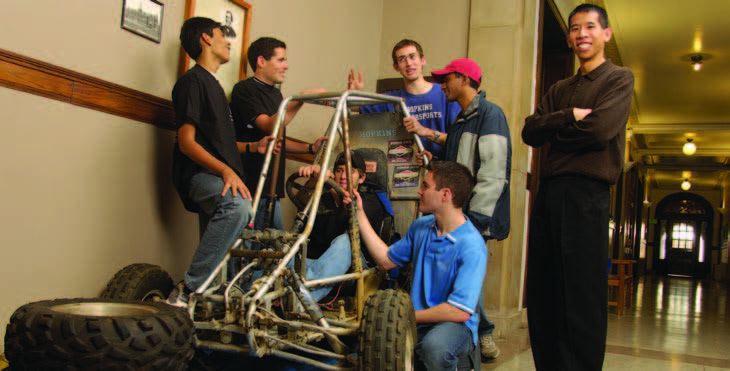
Adam Baumgartner, a sophomore mechanical engineer, is talking in a corner of Latrobe Hall’s basement. He’s describing his involvement on the Hopkins Baja-SAE team and is so excited that he’s actually jumping up and down in place. Standing 6 feet 8 inches (he’s also a forward on Hopkins’ men’s basketball team), he has enthusiasm that is both contagious and, in this cramped setting, slightly overwhelming.
The object of his excitement? A 10-horsepower, dune buggy–type vehicle that he and his Hopkins classmates are crafting to compete in an intercollegiate design competition run by the Society of Automotive Engineers (SAE). The single- seater must be equipped to race across rough terrain, catch air, and chug through deep water. The team’s goal: to create the most efficient machine that can take part in speed, distance, and durability competitions in a wide variety of settings.
Baumgartner’s co-captain for the 2007–2008 season is Avik De, also a sophomore mechanical engineer. Together the two are leading a group of 14 undergraduates (many from Mechanical Engineering, but others from Physics, Biomedical Engineering, and even International Relations) in the design and construction of the vehicle.
After planning, refining, and strategizing their design within the constraints defined by the SAE, the students will build and test the car. Later this spring, the team will compete in a series of international competitions against schools from across the United States, Canada, Latin America, and Korea. They will be judged on their design, cost, speed, traction, land maneuverability, water maneuverability, and endurance.
This marks the fourth year that a Whiting School team will compete in the contest. “Two super-motivated students started it here in 2004 and it is students that have made it a success,” says Lester Su, an assistant professor of mechanical engineering and the team’s faculty advisor.
Each team starts with the same 10-horsepower Briggs & Stratton engine and is allowed to cannibalize a percentage of parts from its previous year’s entry. “We’re making it substantially lighter than last year’s by taking out unnecessary tubes, completely redesigning the drive train, and making our own two-stage chain reduction box,” De says. “It’s a completely redesigned chassis,” adds Baumgartner.
When De explains that the car is designed entirely on the computer, Eric Harden, the department’s senior machine shop coordinator, chimes in, “But just because the computer says it works, that doesn’t mean it works.” While competing is clearly a thrill, the team obviously enjoys putting classroom learning to hands-on use. “There are trade-offs we have to make at every stage. But we’ve had the chance to learn how to use all these tools,” Baumgartner says, walking through the machine shop. “We learned to weld, which is cool. This is a dream come true for me. Definitely something to check off on my life ‘to-do’ list.”
To find out how the 2007–2008 team fares, check its website, http://www.jhu.edu/asme/baja .html, later this spring.




